How to Plant Durian: A Step-by-Step Guide to Cultivating the King of Fruits
- March 18, 2024
- 6 comment
Durian, often called the “King of Fruits” in Southeast Asia, stands out for its large size, distinctive smell, and tough, thorn-covered husk. While its scent is polarizing, durian is loved for its creamy, custard-like texture and sweet, rich flavor. If you’re looking to grow your own, understanding the key steps for planting and caring for a durian tree is essential. In this guide, I’ll walk you through everything you need to know to successfully plant a durian tree and enjoy its delicious fruit.
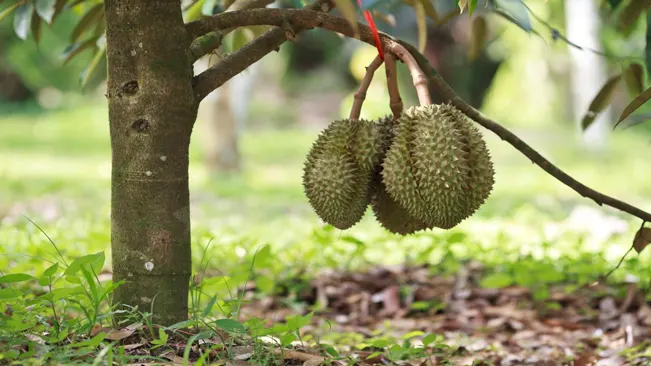
Benefits of Durian
| Benefit | Description |
|---|---|
| Nutritional Value | High in calories, vitamins C and B complex, and minerals such as potassium, iron, and magnesium. |
| Antioxidant Properties | Contains antioxidants like flavonoids, polyphenols, and tannins, which help combat free radicals. |
| Heart Health | Rich in potassium and fiber, which are beneficial for heart health and blood pressure regulation. |
| Digestive Health | The fiber in durian aids in bowel regularity and promotes a healthy digestive system. |
| Anti-Aging | Vitamin C and other antioxidants in durian can help combat skin aging by reducing the appearance of wrinkles and age spots. |
| Energy Booster | High in natural sugars, which provide an immediate energy boost. |
| Bone Health | Contains calcium, potassium, and B vitamins, which are essential for maintaining healthy bones and joints. |
| Sleep Aid | Contains tryptophan, an amino acid that can be converted into serotonin and melatonin, which help regulate sleep. |
| Mood Enhancer | The presence of various vitamins and minerals, along with its unique taste, can uplift mood and reduce stress. |
| Immune System Support | The high vitamin C content helps bolster the immune system and improves resistance to infections. |
List on How To Plant Durian
- Choosing the Right Durian Variety
- Selecting a Suitable Location
- Preparing the Planting Site
- Planting the Tree
- Caring for Your Durian Tree
- Patience is Key
Choosing the Right Durian Variety
Durian, scientifically known as Durio zibethinus, has numerous cultivars, each boasting unique characteristics such as flavor, texture, and size. Here are some of the most popular varieties:
Musang King (Mao Shan Wang)
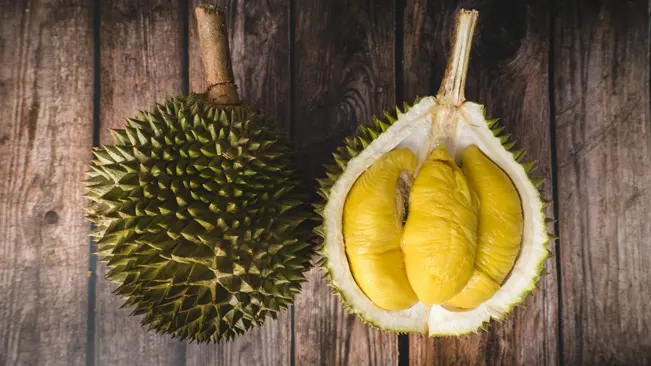
- The Musang King variety is one of the most prized types of durian, known for its creamy texture and bittersweet flavor. This variety has thick, golden-yellow flesh and is highly sought after in places like Malaysia and Singapore. If you’re planting a Musang King durian tree, it’s important to understand its specific care requirements to ensure healthy growth and fruit production. Proper care can make all the difference in enjoying the unique taste and texture that makes Musang King so special.
D24 (Sultan)
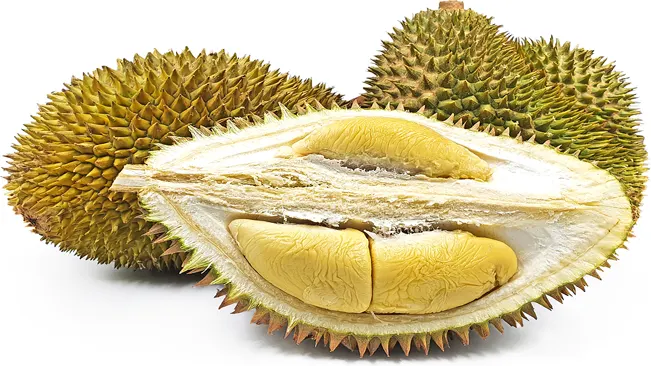
- The D24 durian variety is another fan favorite, known for its rich, creamy texture and slightly bitter taste. While it has a more subtle flavor than the Musang King, it remains a popular choice among durian enthusiasts. If you’re planning to plant a D24 durian tree, following the right steps from planting to care is essential to help it thrive. Proper cultivation of this variety ensures that you’ll enjoy its distinctive flavor when the fruit is ready for harvest.
Red Prawn (Udang Merah)
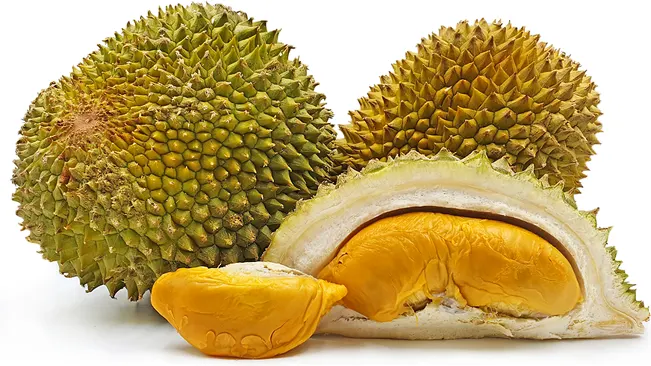
- This durian variety, known for its orange-red flesh, stands out due to its sweet taste and slightly mushy texture. It’s a great choice for those who prefer a sweeter, less bitter durian. To successfully grow this variety, selecting the right soil is crucial. Durian trees thrive in well-draining, fertile soil that provides the nutrients needed for strong growth and flavorful fruit. Understanding the best soil for durian trees will ensure you cultivate a healthy tree with high-quality durians.
Green Skin (D145)

- The Green Skin variety of durian is known for its thick, creamy texture and sweet flavor. As the name implies, its skin stays green even when the fruit is ripe. To grow a healthy Green Skin durian tree, using the right fertilizer is key. A balanced fertilizer that provides essential nutrients, such as nitrogen, phosphorus, and potassium, will help support the tree’s growth and enhance the quality of the fruit. Proper fertilization ensures that the tree produces high-quality durians with that characteristic sweet flavor and creamy texture.
Monthong
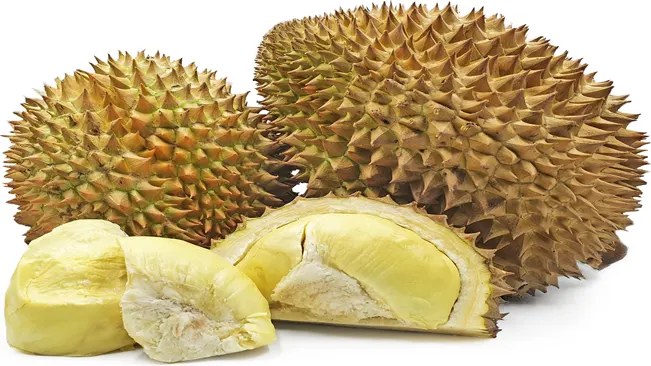
- Originating from Thailand, the Monthong variety is one of the largest durian types. Known for its mildly sweet flavor and firm texture, Monthong is a popular choice among those new to durian. It’s also less odorous compared to other varieties, making it more approachable for first-timers. To grow a healthy Monthong durian tree, it’s important to understand its specific requirements, including the right climate, soil, and care techniques. Meeting these needs will ensure the tree produces high-quality, flavorful fruit.
When selecting a durian variety to plant, consider the following factors:
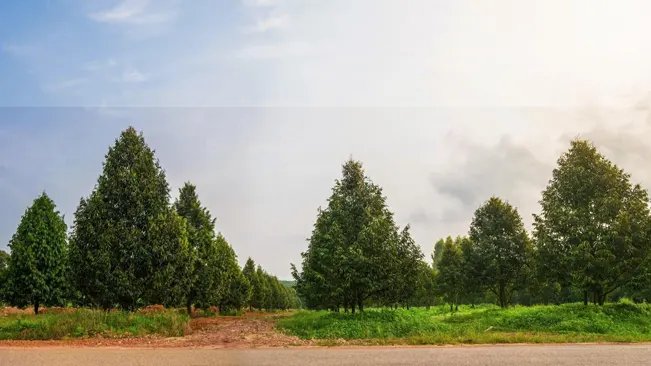
- Climate Compatibility: Different varieties have different climate preferences. While some thrive in humid and rainy conditions, others might require drier climates. For instance, Thai varieties like Monthong are more suited to slightly drier conditions compared to Malaysian varieties.
- Soil Requirements: Ensure that the variety you choose is compatible with the soil type in your area. While durian generally prefers well-drained, fertile soils, some varieties may have specific nutrient requirements.
- Space and Size: Some durian trees grow larger than others. If space is limited, consider a variety that grows to a smaller size.
- Pest and Disease Resistance: Some varieties are more resistant to certain pests and diseases. Researching this can save a lot of effort in pest and disease management.
- Market Preferences: If you are planting durians for commercial purposes, consider the preferences of your target market. Some varieties may fetch higher prices due to their taste and rarity.
Selecting a Suitable Location
Climate
Durian trees are native to tropical regions and hence, they flourish in environments that mimic their natural habitat. The key climate factors include:
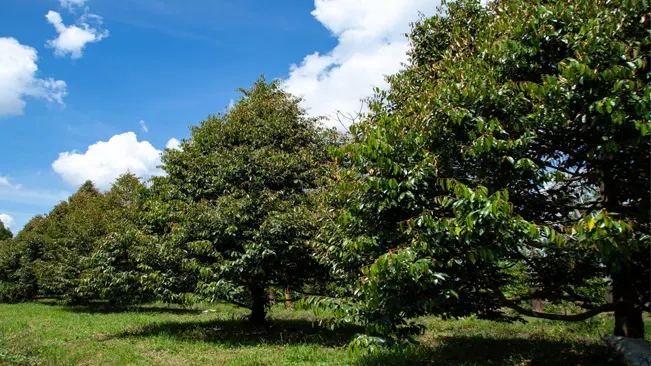
- Temperature: Durian trees thrive in temperatures ranging from 24°C to 30°C (75°F to 86°F). They are highly sensitive to cold and cannot withstand temperatures below 10°C (50°F). Frost is particularly detrimental and can cause significant damage or even kill the tree.
- Rainfall: These trees need a high level of humidity and regular rainfall. An annual rainfall of about 1,500 to 3,000 mm is ideal. However, it’s important to note that durian trees require a dry period of about 1 to 2 months before the flowering season for optimal fruit production.
- Wind: Durian trees can be vulnerable to strong winds due to their large canopy and heavy branches. Protection from strong winds, such as planting in a sheltered location or using windbreaks, can be beneficial.
Soil
The health of the durian tree is significantly influenced by the soil in which it is planted. Key soil characteristics include:
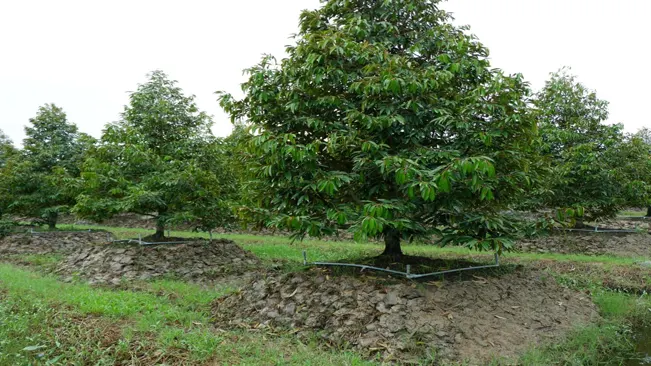
- Fertility: Durian trees require nutrient-rich soil for optimal growth and fruit production. The soil should be rich in organic matter, which can be enhanced by adding well-rotted manure or compost.
- Drainage: Well-drained soil is crucial to prevent waterlogging, which can lead to root rot. While the tree requires moist soil, excessive water can be detrimental.
- pH Level: The ideal pH level for durian soil is slightly acidic to neutral, typically ranging from 5.5 to 6.5. Testing the soil pH can help in amending the soil accordingly if it’s not within the desired range.
- Soil Depth: Durian trees have deep root systems, requiring deep soil for proper growth. Shallow or rocky soils can impede root development and overall tree health.
Sunlight
Sunlight is a critical factor for the durian tree, especially for fruit production:
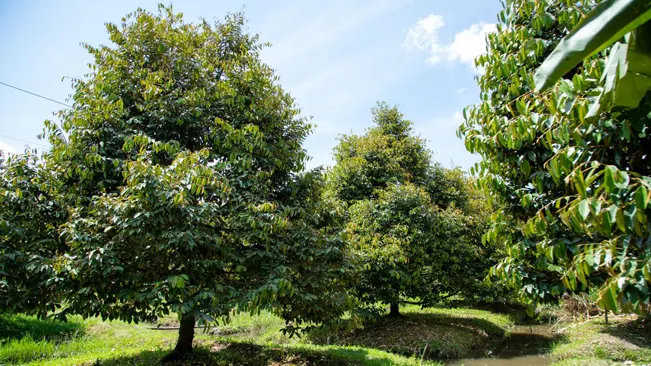
- Full Sunlight: Durian trees require full sunlight for at least 6 hours a day. This is essential for the photosynthesis process and overall health of the tree.
- Shade Tolerance: While young durian trees can tolerate some shade, mature trees need full sunlight. Shaded conditions can lead to poor growth and reduced fruit yield.
Preparing the Planting Site
Soil Preparation
Proper soil preparation is critical for the healthy growth of durian trees. Here are the key steps and considerations:
- Assessing Soil Quality: Begin by testing the soil for its pH level, nutrient content, and drainage ability. Durian trees prefer slightly acidic to neutral soil (pH between 6 and 7). The soil test will help you understand what amendments are needed.
- Improving Drainage: Durian trees do not tolerate waterlogged conditions. If your soil is heavy or clayey, improving drainage is essential. You can do this by adding coarse sand or gravel to the soil. This will increase the porosity and help excess water to drain away from the root zone.
- Adding Organic Matter: Organic compost is vital for enriching the soil. It provides essential nutrients and improves soil structure, which enhances water retention and aeration. Well-composted organic matter like aged manure, composted leaves, or commercial organic compost should be mixed into the top layer of the soil.
- Tilling the Soil: Loosen the soil to a depth of at least 2 feet. This is important for the deep root system of the durian tree. It allows the roots to penetrate deep into the soil, which is vital for stability and nutrient uptake.
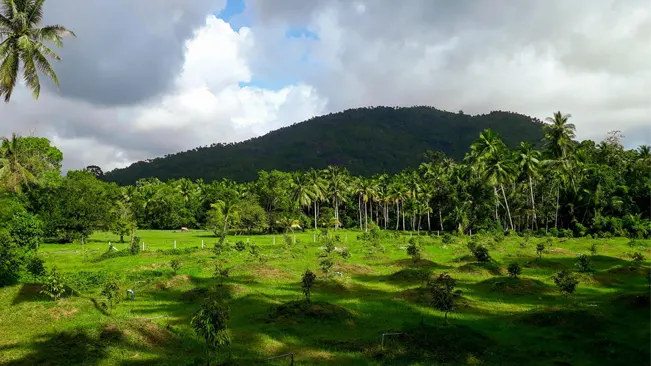
Spacing
Durian trees are large and need ample space to grow. Here’s why proper spacing is crucial:
- Avoiding Overcrowding: Each durian tree needs enough space to spread its roots and branches. Overcrowding can lead to competition for nutrients, water, and sunlight, hampering the growth and fruit production of the trees.
- Optimal Spacing: A spacing of 35 to 40 feet between each tree is recommended. This allows enough room for each tree to grow without interference and ensures adequate airflow, which is important for reducing the risk of fungal diseases.
- Planning for Future Growth: Durian trees can grow quite tall and wide. When planting, it’s important to visualize the mature size of the trees and space them accordingly. This foresight helps in managing the orchard effectively in the long run.
- Accessibility: Proper spacing also facilitates easier access for maintenance, harvesting, and monitoring the health of each tree.
Planting the Tree
Choosing Between Seedlings and Grafted Trees
Seedlings
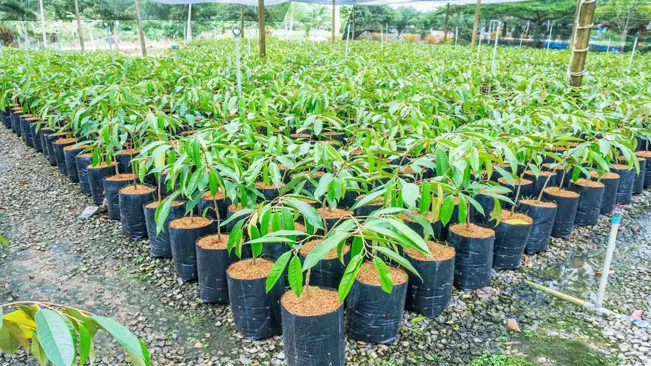
- Growing durian from seeds is a longer and less predictable process. Seed-grown trees may take longer to bear fruit, often up to 8-12 years. Additionally, the fruit quality and characteristics may not be identical to the parent tree, as durian trees are heterozygous. This genetic variability means that each seedling is unique and may produce fruit that differs in size, taste, and texture.
Grafted Trees
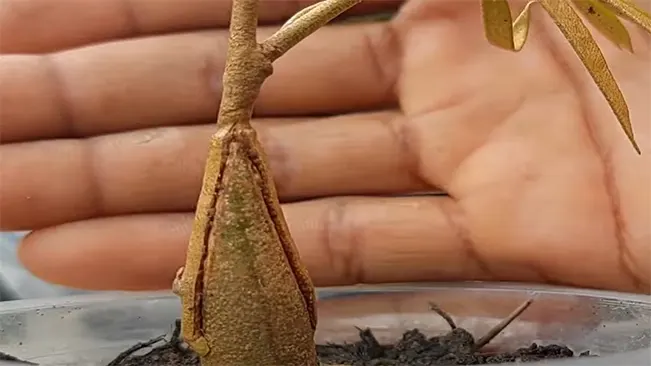
- Grafted trees are the preferred choice for commercial and serious growers. Grafting involves attaching a scion (a young branch) from a mature, fruit-bearing durian tree to the rootstock of another tree. This method ensures that the fruit quality and characteristics are consistent with the parent tree. Grafted trees also start bearing fruit much sooner, typically within 4-6 years. The predictable nature of grafted trees makes them a more reliable option for those aiming for specific durian varieties and quality.
Planting Techniques
- Timing: Plant durian trees during the rainy season if possible, as the moist soil helps the young trees to establish more easily.
- Hole Preparation: When digging the hole, make sure it’s about twice the size of the root ball of your tree. This size ensures that the roots have enough space to spread out and access nutrients and water in the soil.
- Positioning the Tree: Place the tree gently in the hole, making sure it’s upright and centered. The graft union (if it’s a grafted tree) should be above the soil level. This union is where the scion meets the rootstock, usually noticeable by a slight bulge or change in bark texture.
- Backfilling: Fill the hole with soil, ideally a mix of the original soil and some organic compost. Compost enriches the soil with nutrients, aiding in the tree’s growth. Be careful not to overly compact the soil, as good aeration is crucial for root health.
- Watering: After planting, water the tree thoroughly. This initial watering helps to settle the soil around the roots and eliminates air pockets. Ensure the soil is moist but not waterlogged.
- Mulching: Apply a layer of organic mulch around the base of the tree. Mulch helps retain soil moisture, regulate soil temperature, and reduce weed growth.
- Staking: In windy areas, staking the young tree can provide additional support and prevent it from leaning or uprooting.
- Initial Care: For the first few weeks, monitor the tree closely, especially its water needs. The goal is to keep the soil consistently moist but not soggy.
Caring for Your Durian Tree
Watering Durian Trees
Durian trees, being tropical, thrive in conditions where moisture is consistent. Here are some tips for effective watering:
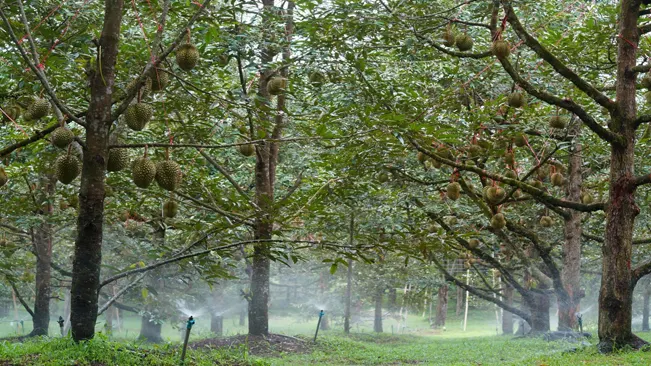
- Regular Watering: Durian trees need regular watering to maintain soil moisture, particularly during dry spells. However, it’s crucial not to waterlog the soil as this can lead to root rot.
- Monitoring Soil Moisture: Check the soil moisture frequently. The soil should be moist but not saturated. During rainy seasons, you might need to reduce watering.
- Mulching: Applying a layer of organic mulch around the base of the tree can help retain soil moisture and regulate temperature.
Fertilizing Durian Trees
Fertilization is essential for the growth and fruit production of durian trees. Here are some guidelines:
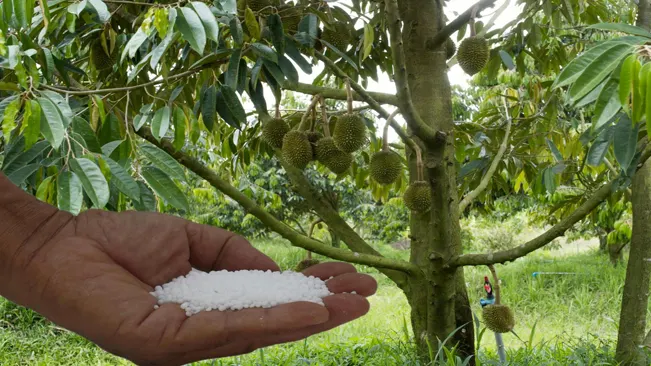
- Organic Fertilizers: Use organic fertilizers like composted manure or bone meal to enrich the soil with nutrients.
- Balanced Nutrients: Ensure that the fertilizer has a balance of nitrogen, phosphorus, and potassium, along with essential micro-nutrients.
- Regular Application: Apply fertilizer every three to four months, adjusting based on the tree’s growth and health. Young trees require more frequent fertilization.
Pruning Durian Trees
Pruning is crucial for maintaining the tree’s health and structure:
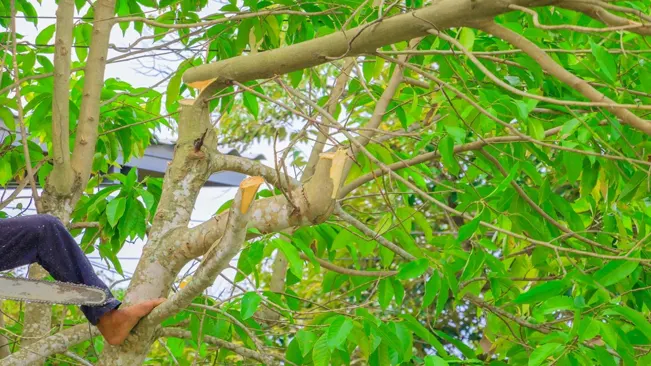
- Removing Dead or Diseased Branches: Regularly inspect for and remove any dead or diseased branches to prevent the spread of disease and to improve air circulation.
- Shaping the Tree: Prune to shape the tree and manage its size. This helps in maintaining the tree’s health and facilitates easier harvesting.
- Pruning Technique: Use clean, sharp pruning tools to make clean cuts. This helps the tree heal faster and prevents disease.
Pest and Disease Control in Durian Trees
Durian trees can be susceptible to certain pests and diseases. Effective management includes:
- Regular Monitoring: Frequently inspect the tree for signs of pests or disease. Early detection is key to effective control.
- Organic Pest Control: Use organic pest control methods such as neem oil or insecticidal soaps to manage infestations while keeping the ecosystem safe.
- Disease Prevention: Ensure good air circulation and avoid injuring the tree, as wounds can become entry points for disease.
- Natural Predators: Encourage natural predators in your garden, such as birds and beneficial insects, to control pest populations.
- Cleanliness: Keep the area around the tree clean and free of debris to reduce the likelihood of disease and pests.
Patience is Key
Understanding Durian Tree Maturity

- Growth Phases: Durian trees go through several growth phases before they start fruiting. Initially, they focus on developing a strong root system and foliage. This period is crucial for establishing a healthy foundation for future fruit production.
- Tree Maturity: Unlike some fruit trees that start bearing fruit within a few years, durian trees typically take longer to mature. This prolonged maturation period is necessary for the trees to develop the necessary structure and strength to support the heavy fruits.
Factors Influencing Fruit Bearing Age

- Variety: Different durian varieties have varying maturation times. Some may start fruiting a bit earlier than others.
- Environmental Conditions: The local climate and soil conditions greatly affect the growth rate of durian trees. Ideal conditions can encourage earlier fruiting.
- Tree Health and Care: Regular care, proper fertilization, watering, and pest management contribute to the overall health of the tree and can influence how soon it starts fruiting.
The Rewards of Patience
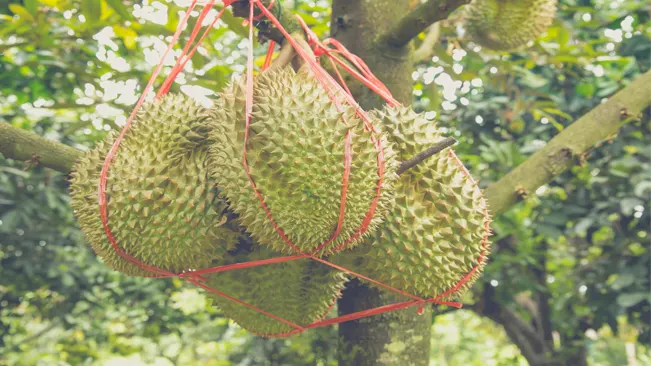
- Quality of Fruit: Mature trees, having fully developed, often produce higher quality fruit. The flavors and textures of durians from well-established trees are usually superior.
- Yield: As the tree matures, its fruit-bearing capacity increases. Older trees can produce a more significant number of fruits per season.
- Tree Longevity: A well-cared-for durian tree, given time to grow and strengthen naturally, can bear fruit for many decades, making it a long-term investment.
Cultivator’s Journey
- Observation and Learning: The years leading up to the first harvest allow cultivators to learn about their tree’s specific needs and behaviors, fostering a deeper connection with their plant.
- Anticipation and Reward: The anticipation of the first fruit, followed by the satisfaction of the harvest, can be incredibly rewarding, symbolizing the culmination of years of dedicated care.
Related Post:
- How to Grow Breadfruit: Essential Tips for a Thriving Tree
- How to Grow Jackfruit: A Beginner’s Guide
- How to Grow Runner Beans: A Comprehensive Guide for Bountiful Harvests
- How to Grow Jicama: Your Easy Guide to Cultivating the Mexican Yam Bean
- How to Grow Cinnamon Basil: A Beginner’s Guide to Aromatic Gardening
- How to Grow Roma Tomatoes: Expert Tips for a Lush Homegrown Harvest
- How to Grow Blackberries: Easy Steps to Grow and Nurture Your Own
- How to Fertilize Durian Trees Effectively: From Beginner to Expert
Conclusion
Planting a durian tree can be a rewarding experience, both for the challenge it presents and the delicious fruits it eventually yields. By following these guidelines, you can successfully grow and enjoy your own durian fruits. Remember that the key to success lies in understanding and meeting the specific needs of the durian tree, from soil conditions to climate and care. With dedication and care, you can look forward to the unique experience of harvesting your own durians.
FAQs (Frequently Asked Questions)
- What climate is best for growing durian trees?
Durian trees thrive in hot and humid tropical climates. They require consistent temperatures between 24°C to 30°C (75°F to 86°F) and high humidity levels. - How much sunlight does a durian tree need?
Durian trees need full sunlight. Choose a planting location that receives direct sunlight for most of the day. - What type of soil is ideal for durian trees?
Durian trees grow best in deep, fertile, well-drained soil rich in organic matter. The soil pH should ideally be slightly acidic to neutral. - How much space do durian trees need?
Durian trees can grow quite large, so space them about 35 to 40 feet apart to allow for adequate growth and air circulation. - Is it better to plant durian from seed or a grafted tree?
Planting a grafted tree is generally preferable as it ensures better fruit quality and a shorter time to fruiting compared to growing from seed. - How often should I water my durian tree?
Regular watering is important, especially in dry periods. The soil should be kept moist but not waterlogged. Adjust watering based on rainfall and soil moisture levels. - What type of fertilizer should I use for durian trees?
Use organic fertilizers such as composted manure or bone meal. Fertilize every three to four months, ensuring a balance of nitrogen, phosphorus, and potassium. - How do I prune a durian tree?
Prune to remove dead or diseased branches and to shape the tree. Pruning helps maintain the tree’s health and facilitates harvesting. - What are common pests and diseases that affect durian trees?
Durian trees can be affected by pests like mealybugs, aphids, and diseases such as root rot and stem cankers. Regular monitoring and organic pest control methods are recommended. - How long does it take for a durian tree to bear fruit?
Durian trees typically start bearing fruit in 5 to 10 years after planting, depending on the variety and growing conditions. Patience is key in durian cultivation.
For more expert gardening and advice, explore our guides, discover top recommendations in our best section, and delve into in-depth product reviews in our review section. Happy Gardening.

Kristine Moore
Forestry AuthorI'm Kristine Moore, a seasoned garden landscaping professional with over 30 years of experience. My extensive career has been dedicated to transforming outdoor spaces into stunning, sustainable landscapes. With a deep understanding of horticulture, design principles, and environmental stewardship, I have become a respected figure in the field, known for creating harmonious, visually appealing, and eco-friendly gardens. My commitment to excellence and continuous learning in landscaping trends and techniques has solidified my reputation as an expert in garden design and implementation.
6 comments
These are not local varieties. I am from Davao City and the most popular variety is Puyat. There are other varieties such as Arancillo, D-101, etc and our native variety. They prefer shaded environment.
Lynette
March 22, 2024 12:24 pmThank you for highlighting Davao's popular durian varieties like Puyat, Arancillo, and D-101. You're right that these local varieties often prefer shaded environments, which is crucial for their growth in the region. Your insights are very helpful for anyone looking to grow durian in Davao or similar climates.
Kristine Moore
March 25, 2024 5:55 amCara menanam durian
Presely bin baru
March 20, 2024 1:51 pmSaya ada kebun durian tapi cuma 11 pokok. Bole tunjok ajar macam mana nak buat pokok durian membesar dan men jadi supaya dapat buah yang baik.
Mohamed Idrus Bin Idris
March 23, 2024 12:17 amI have generated in vitro technology for rubber, producing about 1 million plantlets with collaboration with RRI China at CATAS. Would be pleased to extend the technology to work on durian. If interested pls contact me. Thanks

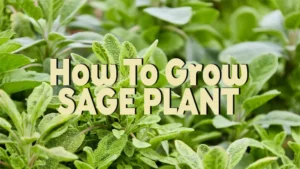
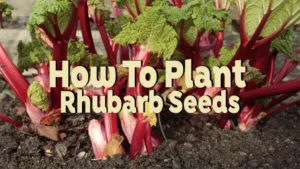




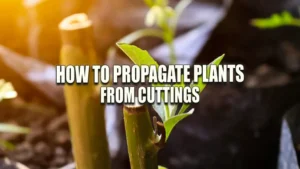





I am most concerned about the fertilization of durian trees. I have spoken to many different people about it. All different answers and vague. Some say organic, some say chemical yet others say mixed. I think ideally it should be mixed. How mixed: one month organic, one month chemical; organic all the way until the flowers start to appear and then chemical until end of season? 2.How often to apply fertilisers: once a month or once in 3 to Months? 3.Does University Pura (Pertanian) have all the answers? Over the phone, they declare they are not experts in durian cultivation. Your advice would be much appreciated. Thanks If you think I should refer to some other authorities on this subject, kindly advise.
Jack Lim
March 26, 2024 3:41 am